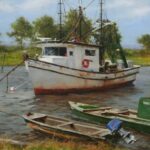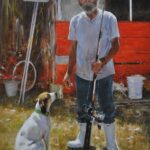
In my opinion, observation skills and a visual interest in how something looks with light on it is what is most important. A personal example might be that I love to paint boats and water, but I know very little about boats except which end is the bow and which is the stern. From observing, I am aware that the shape of a lobster boat is different that that of Shrimp boat, or an Oyster boat, etc. I have a passion for painting boats because I like the shapes and the way they look in water. That is only one example of many subjects that artist choose to paint that do not require expert knowledge to do reasonable representations of them.

By the same token, one can do a very reasonable rendition of the human form without ever taking an anatomy class…..of course anatomy study does not hurt, and I certainly would never discourage any one from studying the human anatomy. Any knowledge gained can be helpful…..particularly in checking one’s self if there is an issue, but it is not an absolute requirement. Artists have done a very good job over the years without studying anatomy, if their observation skills are strong. I believe the artist should be interpreting their observations and not simply copying them. Copying is for cameras. Another problem with relying on knowledge instead of observation is, if one is observing the subject, and something looks vague, fuzzy or not clear as in a shadow area….one should paint that image as they see it, and not use their intellectual knowledge of the subject and make it a clear statement. It will not look appropriate to that particular situation. Example….something dark in shadow value, if made to light and sharp will jump out of the shadow. Another foreseeable problem with using knowledge of subject rather than observation is that one could fall into a formula, and everything starts looking the same. If one is using anatomy knowledge for example. All figures should not be exactly alike.

One could compile a never ending list of subjects that this might apply to. By no means am I implying that one should not learn all one can about the subject they choose to paint….if that is one’s interest. This is only my opinion on this subject, and does not necessarily reflect any universal opinion or idea on the subject. I do find this an interesting topic, and I do believe strong observation skills trump knowledge of a subject as it relates to painting.
Again thanks for listening to my Cajun ramblings.
Robert Simone says
Agreed, the powers of observation and sound draftsmanship reign supreme. I also feel knowledge of subject matter is secondary. But it can be useful. Knowing how a boat should look or what it’s general proportions are can help one detect problems that may occur in drawing, etc. Good article, Hodges. Thanks!
hodges says
Robert; I would have to agree strongly that draftsmanship and high observation skills trump knowledge…..at least in most cases. Thanks for the comment!
Elizabeth Pollie says
This is so well put. I have so many people actually surprised that I neither own a horse or ride one. I agree, it is about observations on many levels. This includes emotional and intellectual perceptions. To me, a painting is a paticular response based on the unique vision of the artist who painted it. Thanks Hodges. Nice article!
hodges says
Thanks Elizabeth for being on the same page with me on this….particularly in regards to the emotional aspect of painting horses. You obviously love horses, or you could not put that much of yourself into these paintings. My passion for this animal, as I mentioned began early on and remains. You don’t own or ride a horse, yet you paint them with great observation skills. I look forward to hanging with you in the “Art of the Horse” at RS Hanna in May. Good luck.
Dave Henderson says
First of all, a big hello from a fellow former illustrator! I remember you from our old Joe Mendola days.
I’ve always loved your work, and today you touch on something
that, at least for me, borders on “pet peeve”. As you speak to what I’d call visual research here, a favorite example comes to mind. Many years ago now, I had a similar discussion with a publisher client. I was doing book covers for him and he expressed frustration with a cover an artist had submitted. The book hadn’t fared well, and the cover image had always bothered him, but he just couldn’t figure out why. This was a ghost story, and the view was looking through an open doorway toward a staircase with a landing. The stairs continued upward to the right. The idea of the illustration was to imply someone we couldn’t see was standing on the stairway. In a moment, I knew what was wrong with the image. Whoever did this cover never took the time to familiarize themselves with “stringers, treads, risers, and a balustrade” and how they all come together. Clearly, the artist had assumed they knew what stairs looked like because they’re familiar. But are they really? The reality is that without taking the time to gain some crucial familiarity with a subject, the artist puts them self in a position to figure it out, and this can lead to problems, and ultimately prove a disservice to the viewer. I think your boat example says it all. I don’t know the difference between lobster, oyster or shrimp boats, nor do I need to know what kind of engines power them, but if I’m showing a painting of lobster men in Maine, they’d better not be in shrimp boats.
Over the years, I’ve painted many horses on book covers for “westerns”,
but I would hardly call myself an equestrian artist. Today, my gallery wants me to paint a traditional portrait of Secretariat. I love a challenge, and I think this one will be fun. So a horse is a horse? I don’t think so. As I prepare for this painting, am I going to learn just what made Secretariat so special?
You bet I will; I owe it to those who appreciate my work….
hodges says
Hi Dave, a big hello to another former illustrator! Illustrators are constantly asked to illustrate pictures of subjects they know little or nothing about until the assignment is in front of them. Researching subjects was a big part of the job…..as I recall. Finding images that could be used, and shooting reference was paramount….and dictated success or failure. Again, observation skills. Good luck with the Secretariat portrait. I’m sure it will be a great success! Thanks for the thoughtful comment.
Tom Martino says
Hodges, I agree that direct observation goes beyond knowledge of the subject, particularly in the case of figurative art. I too had the experience of painting alongside an accomplished figure painter (actually holding an MFA in the subject). When we finished the session my painting friend’s figure painting, although flawless in ideal proportions, looked like a textbook example, not the subject figure on the modeling stand before us. Painting must involve close observation and sympathetic handling.
hodges says
Tom, this is exactly what I meant about everything looking alike if knowledge rather than observation is method applied. A very good example…thanks for the comment!
Theresa Grillo Laird says
Hodges, I completely agree that observing is the best way to go about painting what’s in front of you. Yet I still run into difficulty painting in a place with totally different light and colors than what I’m used to -California coast compared to the Florida coast for example.I can clearly see the differences but the more time I spend in a place the easier it is to get the paint to do what I’m after.
hodges says
Theresa, of course there is an adjustment to be made with different light, but it still ultimately comes down to seeing it….some folks get it quicker than others do. It is like trying to paint from a north light studio with subtle cool light coming in after being accustomed to a stronger warm incandescent light…..or, grey day, as opposed to sunny day. Thanks for the great comment.
Austin Painter says
Since I paint most of my portraits from photographs, I have struggled with this same question. Knowing the subject allows you to add features that are not captured in the photo; so I think this is generally beneficial. But many times I add similar (imagined) features to paintings from photos, too. So it works either way.
hodges says
I think the struggle with photographs is universal. The biggest problem with photos is that the camera, as good as they are now, can’t see what the human eye can see. Obviously it is not always possible to have the live model to paint from, so I try to paint as much as possible from life…..if nothing else, it makes one aware of the deficiencies in photos. I find for example, shadows get inky in photos and need more air in them. Thanks for the comment.
Tom Watson OPA says
Hodges, during my 40 year career as a west coast illustrator, I too drew and painted a multitude of subject matter, and often I knew little about the subject.. in some cases it did not even exist. A fantastic illustration instructor I had, believed that if you learn to draw and paint the human figure convincingly, in all its complex animation and complicated perspectives, you could draw and paint anything.. with or without knowledge of the subject matter. His name was Robert (Bob) Foster, and he became a well known science fiction soft book cover illustrator during the 1960s’ and early 70s’. The great portrait painters of the past certainly knew less than friends or family about their subject, but they were masters of observation and knew what to look for in seeking out the personality of their subject. Without superior drawing and painting skills however, they could not convert their observations into a great portrait. I think individual taste also plays a big role in the equation.